Cultivation of grain crops is the most important agricultural industry. These plants provide animal feed and industrial raw materials. Cereal crops occupy one of the most important places in the food industry.
General classification
Cereal crops are divided into legumes and cereals. The latter mostly belong to the botanical cereal family. The main crops are:
- Millet.
- Sorghum.
- Corn.
- Barley.
- Millet.
- Rye.
- Wheat.
- Buckwheat and others.
The value of plants
Cereal products are used for the development of animal husbandry and poultry farming. A large amount of nutrients contained in plants contributes to the active growth of livestock, an increase in milk yield. Such important products as pasta and bread products, flour, cereals are also produced from grain. Plants act as raw materials for the production of starch, alcohol, molasses, and so on.
Chemical composition
Grains are rich in carbohydrates and proteins. The latter are present in amounts from 10 to 16%. Carbohydrates in plants contain from 55 to 70%. Most cereals contain 1.5 to 4.5% fat. It contains about 6% in corn and oats. The percentage of protein in cereals is not constant. Its share depends on varietal and species characteristics, agricultural practices, climate, weather. Thus, the placement of grain crops in areas with a continental climate, in areas where there is a lot of light and heat, allows you to get plants with more protein than in areas with mild conditions and rainy weather. In addition, an increase in the content of this compound is observed on soils rich in phosphorus and nitrogen. Cereal crops are rich in B group vitamins, PP. Germinated cereals contain C, A and D.
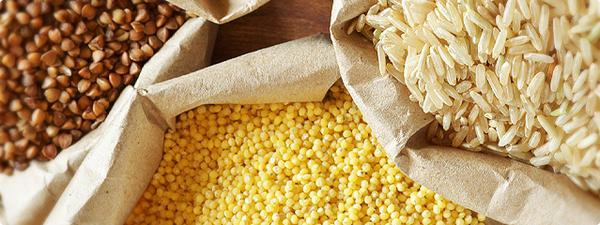
The Importance of Proteins
Compounds that form gluten are of particular value. The baking properties of the resulting flour (volume of products, porosity, elasticity of the dough) will depend on its quality and quantity. A grain of wheat can contain from 16 to 40% crude gluten. Amino acids are present in the protein of cereals. Among them there are irreplaceable - those that are not synthesized in the body of humans and animals. These include, for example, tryptophan, methionine, lysine, and others. These amino acids must be ingested with food. In this regard, their increased content in cereals favorably affects the condition of animals and humans.
nutritional value
It is measured in feed units. For 1 unit It is customary to consider the nutritional value of a kilogram of dry oats. Thus, for 1 kg of wheat and rye, the indicator is 1.18, barley - 1.27, corn - 1.34. The nutritional value of a kilogram of straw can range from 0.2 (wheat, rye) to 0.3-0.35 (barley, oats) feed units.
Topical issues of the industry
Every year programs are developed to increase the yield of grain crops. However, this is not the only task of the agro-industrial complex today. Along with the increase in the volume of raw materials, special attention is paid to its quality. The emphasis, first of all, is on the production of grain crops, which are most in demand in the food and agricultural industries. These include strong and durum wheat, the most important forage and cereal varieties. Many cereal grains, such as oats, barley, rye and wheat, have winter and spring forms. They differ from each other in the way they are grown. The development of winter crops is associated with wintering conditions. Sowing of grain crops is carried out in the fall, and harvesting - for the next year. Spring forms can withstand low temperatures only for a short period. Planting of grain crops in this case is carried out in the spring, and harvesting - in the same year.
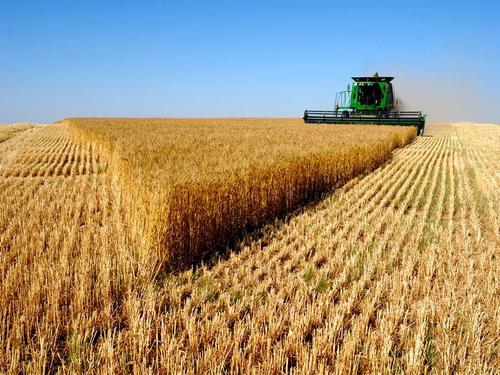
Structure: root system
All grain crops have approximately the same structure. The root system is made up of many adventitious branches, which are collected in a lobe (bundle). Distinguish germinal (primary) roots and secondary. The latter are formed from stem nodes located underground. Most of the roots develop in the arable (top) layer of the earth. Only some branches penetrate deep into the soil: in corn, rice, oats and barley - by 100-150 cm, in rye and wheat - by 180-200 cm, in sorghum - by 200-250 cm. When germinating, the grain first forms primary roots. From the underground nodes of the stem, secondary branches subsequently begin to develop. With enough water, they begin to grow quite quickly. The death of the primary roots does not occur. They play a major role in delivering moisture and nutrients to ground parts. In sorghum and corn, aerial (supporting) roots are formed from above-ground nodes closest to the surface.
Stem
It is called straw. Cereal crops, as a rule, have a hollow stem with 5-6 nodes dividing it into internodes. Straw can reach a height of 50 to 200 cm - it depends on the biological characteristics of the variety and the conditions of its growth. Corn and sorghum have a stalk 3-4 meters or more high. However, a large height is not always considered an advantage of a variety. This is due to the fact that lodging resistance decreases with a long stem.
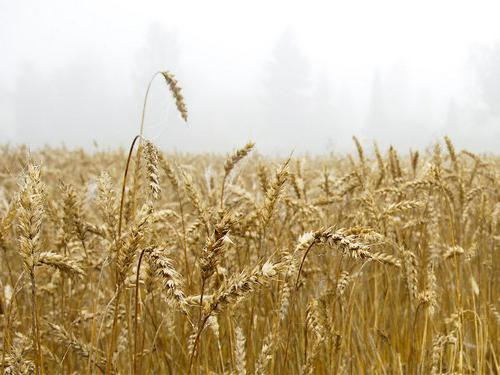
The number of internodes coincides with the number of leaves. The lowest one starts growing first, then all subsequent ones. The stem develops through all internodes. The upper one becomes longer than the lower one towards the end of development. In durum wheat and corn, the stalk is filled with spongy tissue. The lower part is immersed in the soil along with the nodes. They form roots and secondary stems. This part is called the tillering node. When it is damaged, the plant dies.
Leaves and inflorescences
Cereal crops can have linear (rice, oats, rye, wheat), medium (barley) or broad (millet, sorghum, corn) leaves. They are also distinguished by location. Leaves can be stem, basal (rosette) and germinal. All of them consist of a sheath that covers the stem and a plate. In the area where the vagina passes into the plate, there is a tongue - a membranous formation. In triticale, barley, rye, wheat, the inflorescence is a complex ear. Rice, sorghum, millet and oats have a panicle. On one corn plant, a panicle is formed, in which male flowers (sultans) are present, and an ear, where female flowers are located. A rod stands out in the ear. Small spikelets alternately form on its ledges on both sides. The panicle contains branches of the 1st, 2nd and 3rd order. Spikelets are also located at their ends. Flowers are small. They are usually greenish. In the flowers, two scales stand out: internal and external (in spinous forms, it turns into an awn). Inside between them is a pestle. It consists of an ovary, in which there are three stamens and two pinnate stigmas. Cereal crops have bisexual flowers. Their number in the spikelet varies.
Fetus
It is a one-seeded caryopsis, called a grain. Sorghum, rice, barley, oats and millet have scaly fruits. A grain of wheat is covered with a seed coat on top. Under it is the endosperm - mealy tissue. It provides nutrition to the plant during germination. The endosperm contains about 22% protein and 80% carbohydrates of the total grain mass. Under the shell, on the left in the lower corner, are the embryonic root and kidney.
Cereal seeds: sustainability
Dry fruits do not lose their germination capacity even after exposure to liquid hydrogen. Thus, they withstand cooling down to -250 degrees. At the same time, the germinating grain does not tolerate temperatures of -3 ... -5 degrees. The fruits are highly drought resistant. They retain their viability even in cases where they lose almost all moisture. During active growth, however, crops become quite susceptible to dehydration. They can also die with a slight loss of moisture.
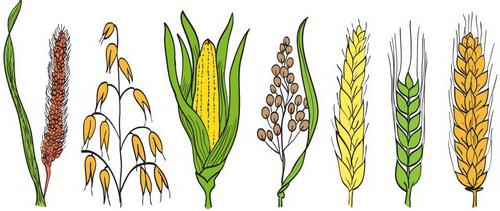
Development phases
Plants go through several stages during the growing season. The following development phases are distinguished:
- Germination of seeds.
- Seedling formation.
- tillering.
- tube formation.
- Sweeping (heading).
- Bloom.
- Formation and filling of grains.
- Maturation.
Germination requires sufficient air, moisture and heat. This process begins after the swelling of the grain. With a sufficient supply of heat, the enzyme system starts in it. As a result of its activity, starch, fats and proteins are transformed into water-soluble, simpler organic compounds. They are nutrients for the fetus. When they arrive, the primary roots begin to grow, and then the stem. When the first unfolded leaf appears above the ground, the seedling formation phase begins. They appear on the 7-10th day.
Wheat
It acts as one of the main grain crops. According to botanical features, soft and durum wheat are distinguished. Depending on the time of sowing, the crop is divided into winter and spring. Soft wheat is distinguished by the fruit of a powdery, semi-glassy or glassy consistency. The grain has a round or oval shape, slightly expanded towards the embryo, with a deep groove and a pronounced beard. The fruit may be yellow, red or white. Soft wheat is used in bakery and confectionery industries. Depending on the technological properties, raw materials are divided into three categories:
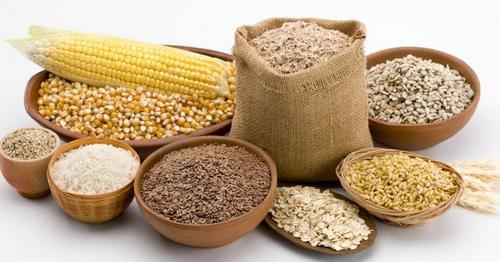
Hard wheat has significant differences from soft wheat. Its fruits are elongated, with a thickening on the embryonic back. Ribbed grain on the cut is translucent, vitreous. The fetal beard is poorly developed, the groove entering shallowly inside is open. The color of the grain can vary from light to dark amber. It contains more sugar, protein and mineral compounds than soft wheat fruits. Hard varieties are used in the manufacture of semolina, pasta. They are also added to wheat, which has poor baking properties. In addition, it is used to obtain semolina flour.
Rye
It is a hardy winter plant. Rye grains are longer than wheat. The color of the fruit can be brown, purple, gray-green, yellow. Gray-green grains are larger than others. It contains more protein. Such grains are distinguished by high baking properties. In rye, less than in wheat, endosperm is present. This, in turn, causes a large number of shells that contain the aleurone layer. On average, about 9-13% of proteins are present in rye. Their peculiarity lies in the fact that they cannot form gluten. In this regard, rye is mainly used for flour production. A small amount of it goes to the production of alcohol and malt.
Triticale
It is a hybrid of rye and wheat. Triticale is a cereal that is winter hardy. Its grains are larger than rye and wheat. From the flour obtained from triticale, gluten is washed. In this regard, its baking properties are close to those of wheat. Depending on the variety, the color of triticale bread can be dark, gray or white.
Millet
This cereal crop is drought tolerant. Millet is a thermophilic plant. It is grown as a spring crop. The fruit of the plant is covered with flower films. They are quite easily separated from the nuclei. The grain of millet can be oval-elongated or spherical, and the endosperm can be mealy or glassy.
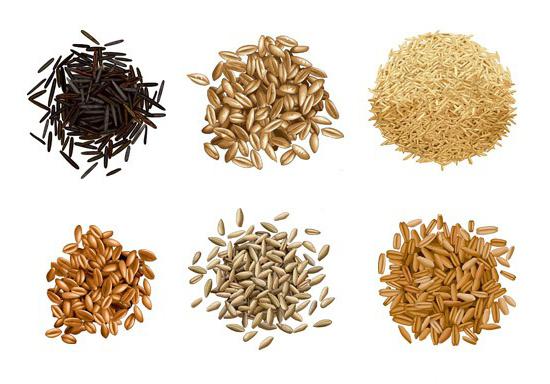
Barley
This spring crop is characterized by a short ripening period (vegetation lasts 70 days). Barley can be two- or six-row. Culture grows everywhere. Groats (barley and pearl barley) are produced from barley. A small amount goes to the production of malt and flour. Barley is considered the main brewing raw material. The cereal is also used as livestock feed.
Rice
This crop loves warmth and moisture. The shape of the fruit can be oblong (wide and narrow) or round. The endosperm is mealy, semi-vitreous and vitreous. The latter is considered the most valuable. This is due to the fact that during the process of hulling (the technological process during which the grain is separated from the shells), vitreous rice is less susceptible to crushing and gives a larger volume of grain.
oats
It's quite a demanding culture. Oats love moisture and warmth. The plant is grown everywhere as a spring crop. The maturation process is quite fast. The grain is yellow or white. In addition to proteins and starch, oats contain a fairly large percentage of fat - about 4-6. The culture is used for fattening livestock and for producing cereals.
